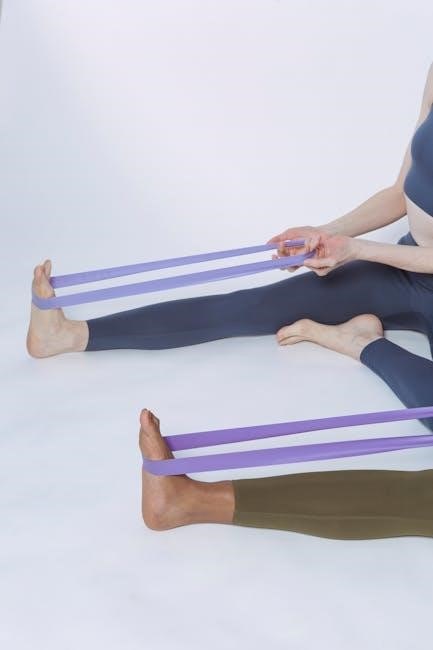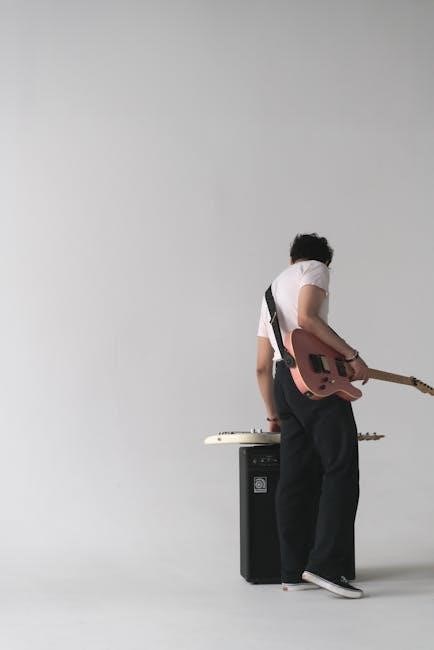IT Band Syndrome Stretches: A Comprehensive Guide (PDF Resources)
Are you struggling with IT band pain? Our comprehensive guide offers various stretches to alleviate discomfort and improve flexibility. Downloadable PDF resources provide detailed instructions and illustrations for each exercise, ensuring proper form and effective relief. Explore our curated collection of exercises today!
Understanding IT Band Syndrome
Iliotibial (IT) band syndrome is a common ailment, particularly among runners and cyclists, characterized by pain on the outside of the knee or hip. This condition arises from the inflammation of the IT band, a thick band of connective tissue that runs along the outside of the thigh, from the hip to the knee. The IT band plays a crucial role in stabilizing the knee and hip during movement.
IT band syndrome typically develops due to overuse, poor training techniques, or anatomical factors such as leg length discrepancy or muscle imbalances; The repetitive bending and straightening of the knee during activities like running can cause the IT band to rub against the bony prominence of the femur (thigh bone), leading to friction and inflammation. Symptoms often include a sharp, burning pain that worsens with activity.
Understanding the underlying causes and mechanisms of IT band syndrome is essential for effective management and prevention. Addressing factors such as muscle tightness, improper biomechanics, and inadequate warm-up routines can significantly reduce the risk of developing this painful condition. Early diagnosis and appropriate treatment are crucial for a swift recovery and return to pain-free activity.
The Role of Stretching in IT Band Syndrome Recovery
Stretching plays a vital role in the recovery process from IT Band Syndrome. A tight IT band and surrounding muscles contribute significantly to the condition, making targeted stretching a cornerstone of rehabilitation. Regular stretching helps improve the flexibility of the IT band itself, as well as the muscles connected to it, such as the tensor fascia latae (TFL) and gluteal muscles.
By increasing flexibility, stretching reduces the friction between the IT band and the lateral epicondyle of the femur, which is the primary cause of pain in IT band syndrome. Stretching also promotes improved blood flow to the affected area, aiding in tissue repair and reducing inflammation. Incorporating a dedicated stretching routine into your recovery plan can significantly alleviate symptoms and accelerate healing.
It is generally advised to stretch for 5-10 minutes before physical activity, preparing the muscles and IT band for the demands of exercise. Consistency is key; performing stretches several times a day, even when not actively exercising, can help maintain flexibility and prevent the recurrence of IT band syndrome. Remember to hold each stretch for 30-60 seconds to allow the muscles to fully lengthen and release tension.
Standing IT Band Stretches
Standing IT band stretches are a convenient and effective way to target the iliotibial band, offering relief and improved flexibility. One common standing stretch involves crossing one leg in front of the other and bending down to touch your toes. By reaching towards the toes of the front leg and even further towards the outside of that foot, you can intensify the stretch along the outside of the opposite thigh, targeting the IT band.

Another effective standing IT band stretch involves leaning sideways against a wall. Stand on the leg on the affected side, positioning that leg close to the wall. Then, cross your other leg in front of the supporting leg and let your hip drop outwards toward the wall. To deepen the stretch, lean away from your affected hip until you feel a noticeable pull along the outside of your thigh.
Remember to maintain a controlled and steady posture while performing these stretches. Hold each stretch for 15-30 seconds, repeating it several times on each side. Consistency is crucial for achieving optimal results. These standing stretches are particularly beneficial as they can be done almost anywhere, making it easier to incorporate them into your daily routine.
Side-Leaning IT Band Stretch
The side-leaning IT band stretch is a highly effective method for targeting the iliotibial band and alleviating tension. Begin by standing with your feet shoulder-width apart, near a wall or stable surface for support, if needed. Cross the leg of your unaffected side in front of the leg on the side you want to stretch.
Next, gently lean your hip of the side you want to stretch towards the wall, allowing the IT band to lengthen. Simultaneously, reach the arm on the same side overhead towards the opposite side, deepening the stretch along the lateral side of your leg and hip. You should feel a noticeable pull along the outside of your thigh, indicating that the IT band is being effectively stretched.
Hold this position for approximately 30 seconds, breathing deeply and maintaining a relaxed posture. Avoid forcing the stretch and listen to your body, ensuring that you only stretch to a point of comfortable tension. Repeat this stretch several times on each side, focusing on consistency and proper form to maximize its benefits for IT band flexibility and pain relief. This stretch can be performed multiple times throughout the day.
IT Band Stretch Using a Wall

The IT band stretch using a wall is a fantastic way to target the often-tight iliotibial band. To perform this stretch effectively, stand with the side of your body that you want to stretch close to a wall. Place the hand nearest the wall on the wall for support, ensuring your body is aligned.
Then, cross the leg furthest from the wall in front of the leg closest to the wall. Gently lean your hip towards the wall, creating a stretch along the outside of your thigh. To deepen the stretch, you can extend your arm that is not on the wall overhead and lean slightly away from the wall.
Hold this position for approximately 30 seconds, breathing deeply and maintaining a relaxed posture. The key is to feel a gentle pull along the IT band without pushing yourself into any pain. Repeat this stretch several times on each side, focusing on consistency and proper form to maximize its benefits for IT band flexibility and pain relief. This stretch can be performed multiple times throughout the day.
Foam Rolling for IT Band Syndrome Relief
Foam rolling is a valuable technique for alleviating IT band syndrome symptoms by addressing muscle tightness and improving tissue flexibility. To begin, position yourself on your side with the affected leg extended and placed on the foam roller. The roller should be positioned along the outside of your thigh, starting just above the knee and extending towards the hip.
Use your arms and opposite leg to support your body weight and control the rolling motion. Slowly roll along the length of the IT band, pausing on any areas that feel particularly tight or tender. Spend approximately 30-60 seconds on each tender spot, allowing the pressure to help release the tension.
Remember to maintain a comfortable level of pressure and avoid rolling directly on the knee joint. This process helps to break up adhesions and improve blood flow to the IT band and surrounding muscles, promoting healing and reducing pain. Regular foam rolling, combined with stretching, can significantly contribute to IT band syndrome relief and improved mobility.
Piriformis Stretch for IT Band Syndrome
The piriformis muscle, located deep in the buttock, can contribute to IT band syndrome symptoms if it becomes tight or inflamed. Stretching the piriformis can help alleviate pressure on the sciatic nerve and improve hip mobility, indirectly benefiting the IT band.
One effective piriformis stretch involves lying on your back with both knees bent. Cross the ankle of the affected leg over the opposite knee. Gently pull the thigh of the bottom leg towards your chest, using your hands to deepen the stretch. You should feel a stretch in the buttock of the crossed leg.
Hold this position for 20-30 seconds and repeat several times. Another variation involves sitting with your knees bent and feet flat on the floor. Place the ankle of the affected leg on the opposite knee. Lean forward from your hips, keeping your back straight, until you feel a stretch in your buttock. Remember to breathe deeply throughout the stretch and avoid any sharp pain. Regular piriformis stretches can help maintain hip flexibility and reduce the risk of IT band issues.
Tensor Fascia Latae (TFL) Stretches
The Tensor Fascia Latae (TFL) is a muscle located on the side of your hip that connects to the IT band. When the TFL becomes tight, it can pull on the IT band, contributing to IT band syndrome; Therefore, stretching the TFL is crucial for relieving tension and promoting flexibility in the hip and leg.
One effective TFL stretch involves standing with one leg crossed behind the other. Reach the arm on the same side as the front leg overhead and lean towards the opposite side. You should feel a stretch along the side of your hip and thigh. Hold this position for 20-30 seconds and repeat several times on each side.
Another TFL stretch can be performed using a wall. Stand sideways to a wall, placing the hand closest to the wall on the wall for support. Cross the leg furthest from the wall in front of the other leg. Gently lean your hip towards the wall, feeling a stretch in the side of your hip. Remember to keep your core engaged and breathe deeply throughout the stretch. Regular TFL stretches can help prevent tightness and reduce the risk of IT band issues.
Strengthening Exercises to Support IT Band Flexibility
While stretching is vital for addressing IT band tightness, incorporating strengthening exercises is equally important for long-term relief and prevention of IT band syndrome. Strengthening the muscles surrounding the hip, glutes, and core provides stability and support, reducing the strain on the IT band. Weakness in these areas can contribute to improper biomechanics, leading to increased friction and irritation of the IT band.
Effective strengthening exercises include hip abductions, glute bridges, clamshells, and single-leg squats. Hip abductions can be performed using a resistance band around your ankles, focusing on controlled movements to engage the outer hip muscles. Glute bridges target the glutes and hamstrings, promoting hip extension and stability. Clamshells isolate the gluteus medius, a key muscle for hip stabilization. Single-leg squats improve balance and strengthen the entire lower body, enhancing overall stability.
Aim to perform these exercises 2-3 times per week, gradually increasing the resistance or repetitions as you get stronger. Remember to maintain proper form throughout each exercise to maximize effectiveness and prevent injury. Combining stretching with strengthening exercises creates a balanced approach to managing and preventing IT band syndrome.
Importance of Consistency and Duration in Stretching

When addressing IT band syndrome through stretching, consistency and duration are paramount for achieving lasting results. Sporadic stretching sessions will likely provide only temporary relief, whereas a consistent stretching routine allows the IT band and surrounding muscles to gradually lengthen and become more flexible. Incorporate IT band stretches into your daily routine, aiming for at least once or twice a day.
Each stretch should be held for a minimum of 30 seconds to allow the muscles and connective tissues to fully release. Avoid bouncing or jerky movements, as this can trigger the stretch reflex and lead to muscle tightening. Instead, focus on slow, controlled movements and deep breathing to promote relaxation and enhance the stretch. Listen to your body and stop if you experience any sharp pain.

Remember that it may take several weeks to notice significant improvements in flexibility and pain reduction. Persistence is key, so stick with your stretching routine even if you don’t see immediate results. Combining consistent stretching with proper warm-up and cool-down routines before and after physical activity will further enhance the effectiveness of your efforts.